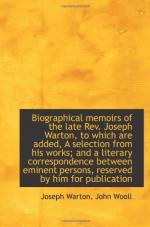|
This section contains 2,197 words (approx. 8 pages at 300 words per page) |

|
SOURCE: Morris, David B. “Joseph Warton's Figure of Virtue: Poetic Indirection in The Enthusiast.” Philological Quarterly 50 (1971): 678-83.
In the following essay, Morris examines Warton's use of his translation of Virgil in his poem The Enthusiast for the significance of departing virtue on his conception of nature and imagination.
Toward the end of Joseph Warton's youthful, bookish poem The Enthusiast or The Lover of Nature (1744), the poet suddenly encounters a train of “awful forms.”1 Sharp-eyed Philosophy, virgin Solitude, and hoary Wisdom pass by; then the parade of abstractions concludes with the figures of Virtue and Innocence:
… last, Virtue's self, Smiling, in white arrayed, who with her leads Sweet Innocence, that prattles by her side, A naked boy!
(220-23)
The enthusiast reacts to these last figures with unusual vehemence, and the poet creates of the encounter an oddly dramatic scene.
Harassed with fear I stop, I gaze, when Virtue thus...
|
This section contains 2,197 words (approx. 8 pages at 300 words per page) |

|


